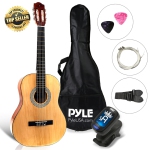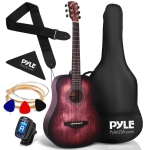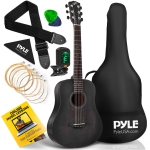Acoustic Guitars
Our Holiday Price Guarantees
Shop deals early knowing that the price of any product with a "Boxing Day Price Now" or "Lowest Price of Dec." badge won't go any lower. If it does, we'll refund the difference. Guaranteed.
Frequently Asked Questions About Acoustic Guitars
Shopping for a new acoustic guitar can be a fun and exciting experience. Though there are a variety of different types and styles to choose from, finding the right one is easy once you know what you are looking for. The best acoustic guitar is going to be one that is comfortable for you to hold, has a body style that matches your personality, and, most importantly, delivers the sound you want.
Which Type of Acoustic Guitar is Right for Me?
Your main decision when choosing an acoustic guitar will be between an acoustic and an acoustic electric. The two types are constructed in the same way and are nearly indistinguishable at first glance.
The largest difference between the two is that an acoustic electric guitar is fitted with an electric pickup. The pickup senses the vibrations produced by the acoustic guitar strings and converts them into an electrical signal. This allows the guitar to be plugged into an acoustic or an audio interface. also usually have a cutaway, which is an indentation in the upper part of the body. The cutaway makes the upper frets more easily accessible, but it can also cause a slight reduction in volume and resonance.
Think about how you plan to use your guitar. If you're just playing for yourself or for friends and family, then an acoustic is a great choice. On the other hand, the ability to plug into an amp is important if you want to play live venues. Likewise, you can quickly and easily record music with an acoustic electric guitar simply by plugging into an audio interface.
What is a good acoustic guitar for beginners?
For beginners, look for a guitar that’s easy to play, has a comfortable neck, and stays in tune. Brands like Yamaha, Fender, and Epiphone offer reliable entry-level models with great sound quality and value.
What is the difference between acoustic and classical guitar?
The main differences are in the strings and build. Acoustic guitars use steel strings and have a brighter, louder sound — great for rock, pop, and folk. Classical guitars use nylon strings, have a wider neck, and produce a warmer, mellower tone — ideal for classical and fingerstyle playing.
Do acoustic guitars need to be tuned often?
Yes. Especially when new, acoustic guitars may go out of tune frequently as the strings stretch and adjust to tension. Over time, tuning will stabilize, but regular tuning is part of basic maintenance.
Different Acoustic Guitar Body Styles
Acoustic guitars come in many different body styles, each of which creates a slightly different sound. Strumming these different types of guitars will allow you to experience a difference in tones and projection, as the shape and dimensions of the guitar body change how the sound resonates. Body style can also impact how comfortable a guitar is for you to hold. Here are some of the most popular body styles that you'll find.
Dreadnought
The dreadnought guitar is the most enduringly popular style. This is the body style that most people imagine when they think of an acoustic guitar. It is known for a powerful and versatile sound that fits right in with a variety of musical genres, including classic rock, bluegrass, punk, indie, and folk.
Concert and Grand Concert
Concert guitars tend to be curvy and smaller in size, making them a popular choice among smaller musicians. Their smaller size also makes for a bright, mid-range sound. Based off a classical guitar shape, the grand concert guitar is a bit larger in size, giving it a larger frequency range and greater projection.
Auditorium and Grand Auditorium
The auditorium is a mid-sized acoustic guitar with a classic hourglass shape that can be held comfortably on the knee. It provides greater volume and tonal range than smaller body styles. Slightly larger still, the grand auditorium guitar was designed to provide an all-around balance of shape, size, comfort, tone, and volume.
Jumbo
A jumbo, as the name suggests, is the largest style of acoustic guitar. The sheer volume of jumbo guitars produces a deep and resonating sound at a high volume, making them the acoustic guitar of choice for country music.
Tonewoods
Like body style, the type of wood used in the construction of your guitar will also influence how it sounds. Knowing what sort of sound you are going for and how you like to play can help you choose from among the following types of popular tonewoods.
Spruce
Spruce is the most common acoustic guitar tonewood. It is a very strong yet lightweight wood that allows for great resonance without any loss of clarity, even when played forcefully. Spruce is a great choice for strumming and flatpicking.
Cedar
Cedar is a soft wood that creates a bright and warm sound when played. It has a quick and rich response that is ideal for lighter playing styles such as fingerpicking.
Mahogany has a strong sound that provides a boost to mid-range tones. It is quite a dense wood, which makes for a slower response that works well for playing country and blues.
Maple
Maple imparts very bright, dry, and well-defined high-end tones to an acoustic guitar. It is a great choice for live settings because it is more easily distinguished through a mix of instruments.
Rosewood
For deep, complex, and warm tones with lots of projection, choose rosewood. This tonewood produces a large range of overtones and is known for its high response rate.
Want more info? Check out some of our resources on the Best Buy blog:






